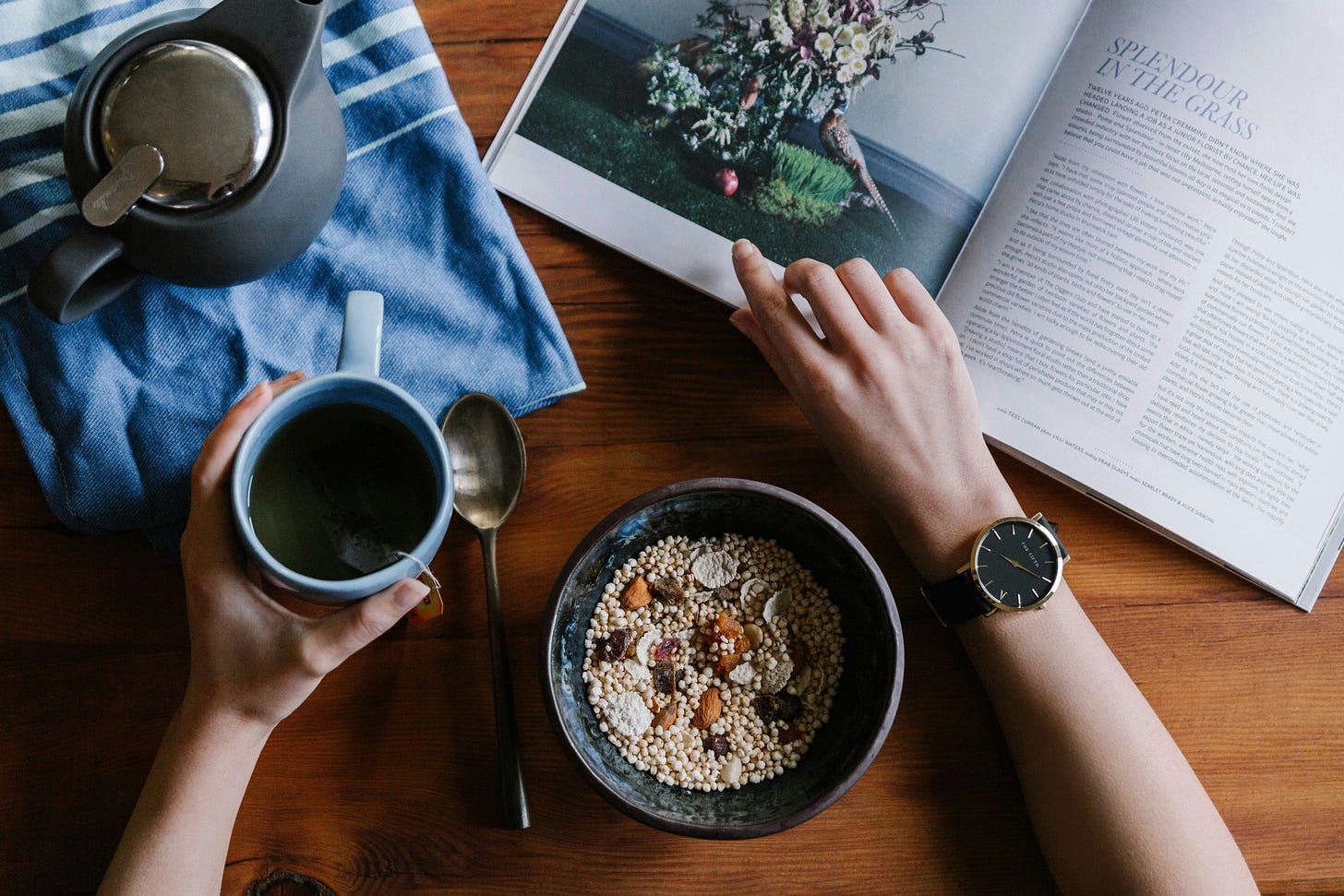Finding inspiration in routine
Creative routines, work life and the power of showing up every day
I’m not very good at making, or keeping, New Year’s resolutions. Maybe you’re like me – you don’t even bother with them in the first place. Or maybe you’re much more organised and have set yourself a whole list of things you want to achieve in 2025. Apparently only 36% of people keep their resolutions past January (so if you’ve got this far, well done you!)
I don’t go in for resolutions, but my interest in day-to-day routines seems to ignite at the start of each New Year. I love learning about how creatives of the past and present got their work done. Perhaps my fascination with routines comes from a hope it might be possible to crack some secret code that means I can get through all my work and life admin and still have a riotous social life. It seems I’m not the only one who has this idea – Google “creative routines” and you’ll tumble down a whole rabbit hole of content (psst: Roz loves rabbit holes! – read her article on them here).
Creative routines
In In Writing by Hattie Criswell, the book based on her successful podcast by the same name, writers of all kinds – journalists, comedians, screenwriters, novelists – share the quirks and idiosyncrasies of their writing routines. The only real unifying factor is that there is none. David Nicholls writes to music. Liane Moriarty writes for timed sprints using an hourglass. Some writers find inspiration in staring out at a beautiful view. Others can’t take the distraction and prefer to face a blank wall.
“I try to get to my desk by 8.30 am every day and actually manage it about once a month. It wouldn’t matter, except my tendency if I don’t is to feel like the entire day is lost and I can’t possibly salvage it. I’m trying to train myself out of it and believe what Hilary Mantel said, that ‘all the world’s a desk’.” Meg Mason, author, in In Writing by Hattie Criswell.
“I get up at about four o’clock in the morning. I discovered by accident that writing at this time of day is wonderful - partly because if you’re quite a gregarious person, you can’t start visiting cafes or phoning your friends.” Barbara Tapido, author, in In Writing by Hattie Criswell.

Getting the work done
I also enjoyed reading Daily Rituals: Women at Work by Mason Currey. Yet, fun as it is to discover that Isabel Allende always begins writing her newest book on 8 January, and Zadie Smith uses internet-blocking software on her computer and steers clear of social media, it can be hard to know what we, mere mortals, can take from these routines and apply to our own lives.
Avid Curiosity Seeds readers will remember the piece I did on cleaning and creativity. That was all about the early stages of creativity, when you’re waiting for that spark of inspiration to land. Author of The Art of Thought, Graham Wallas calls these the incubation and illumination stages of creativity. But what comes next? What happens once you’ve had that great idea while you were doing the vacuum cleaning? That’s where I believe routines come in.
So much of writing and creative work is about discipline – finding a way to focus and show up day after day to get the work done. As Hattie Criswell writes, in In Writing:
“I think the appeal of these routines and rituals is that there’s solidarity in them. Writing asks for endless graft, and because all writers happen to be human, we face the same two mundane challenges: our resolve comes and goes, and our attention is fickle. Good work is really only possible with deep concentration and sustained effort – and a person’s idiosyncratic need to edit on paper, or to keep an admired book in view as a talisman, or to go out for fresh air in the middle of the day, is really just a way of managing human weakness, so that the writing can move ahead.”
This is a learning we can apply to any kind of work, not just writing or creative work. Especially if your work requires long hours of focused attention or, like me, you work from home and need ways to use your time well. Incidentally, although the science isn’t conclusive about the value of routines, it’s thought that the benefit of routines is a kind of positive reinforcement – feel good doing something and you’re likely to want to do it again. Routines also allow us to focus on the task, rather than wasting energy thinking about how or when we’re going to do it.

This year I’ve been taking a fairly meditative approach to my morning routine. I’m in the final throes of writing a novel you see and, before Christmas, I was struggling to find my focus. There was so much going on in the world knocking on my virtual door, trying to claim my attention. Now I’ve settled into a routine that seems to be working well for me: breakfast spent reading In Writing for inspiration; shower, when the ideas seem to percolate and I start coming up ways to crack the scene I’m about to write; desk. I’ve found the key is making sure the shower to desk time isn’t too long – and avoiding that temptation to go on my emails, or the news, or social media when I turn on my computer. If I can get straight into the work, I can put in a good few hours before I need to move on to other work. So in a way, my routine involves a kind of warm up, a way of focusing my attention and keeping unnecessary thoughts at bay. I’ve put down 20,000 words in three weeks alongside other work and responsibilities, so something must be working.
I’m curious to hear about you. Do you have a work routine? What does or doesn’t work for you? Share in the comments – we love hearing from you.
Have we sparked your curiosity? ✨ Read more:
This chart from the wonderful Maria Popova captures Famous Writers’ Sleep Habits vs Productivity – check it out to see whether people in the 4 am club like Haruki Murakami and Sylvia Plath or the 10 am club like James Joyce and Gertrude Stein have been more prolific.
Daily Rituals: Women at Work by Mason Currey. Mason also has a Substack: Subtle Maneuvers, on routines, rituals and wriggling through a creative life.
In Writing, the book and podcast by writer and editor Hattie Crisell



